Building a customer-centric culture.
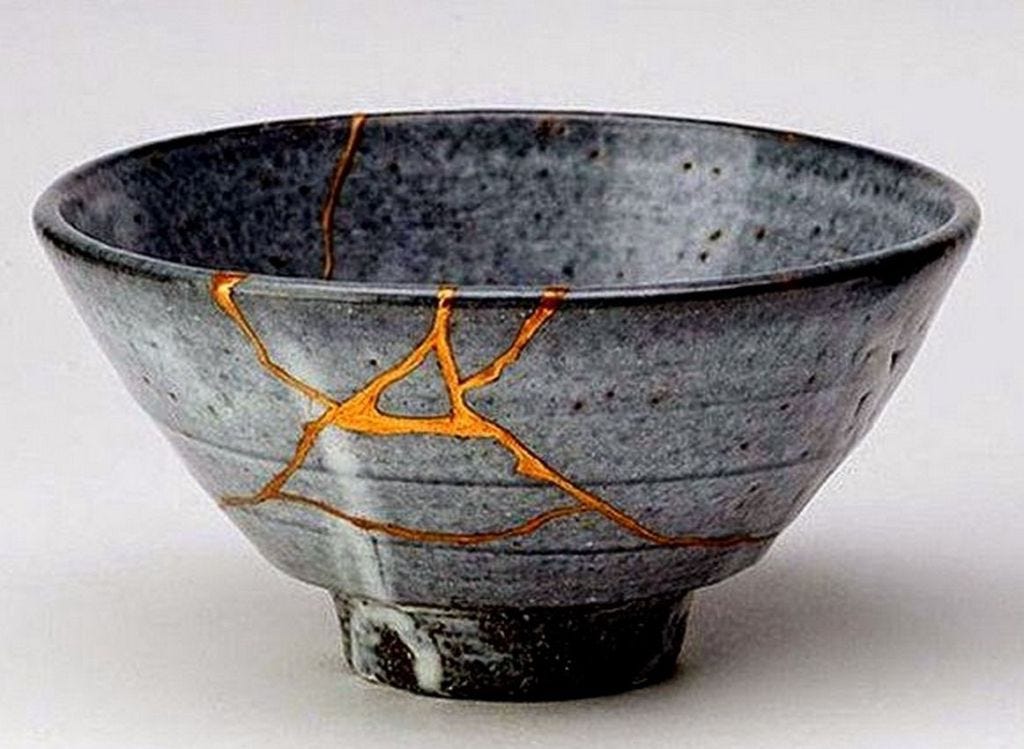
You have studied UX design, read books and blogs, taken workshops, and attended conferences. Your LinkedIn timeline is filled with content about UX processes, showing you what’s the ‘new’ way of doing UX design.
The pressure in the design world is tangible, and you must ensure you are better than a machine at design. AI is coming to steal your job.
But, if you want to find the proper way of doing UX — whatever that means — you better not google it; the internet is a jungle.
It seems that the only way to achieve great results as designers is to aspire to implement an outstanding design process. The pressure on processes is also evident during interviews when we are asked about it constantly.
What if we move away from processes and look at other factors to improve our design practice? Following the ‘correct’ process is not a symptom of a customer-centric business.
Let’s start from the beginning, talking about the design process.
The Design Process: textbook
If you have wondered what process to use when doing UX, the answer is straightforward. All the processes you find in books and online are the same and are all based on User Centre Design (UCD). Debbie Levitt’s article explains it incredibly well by exploring (and mocking!) ten different processes.
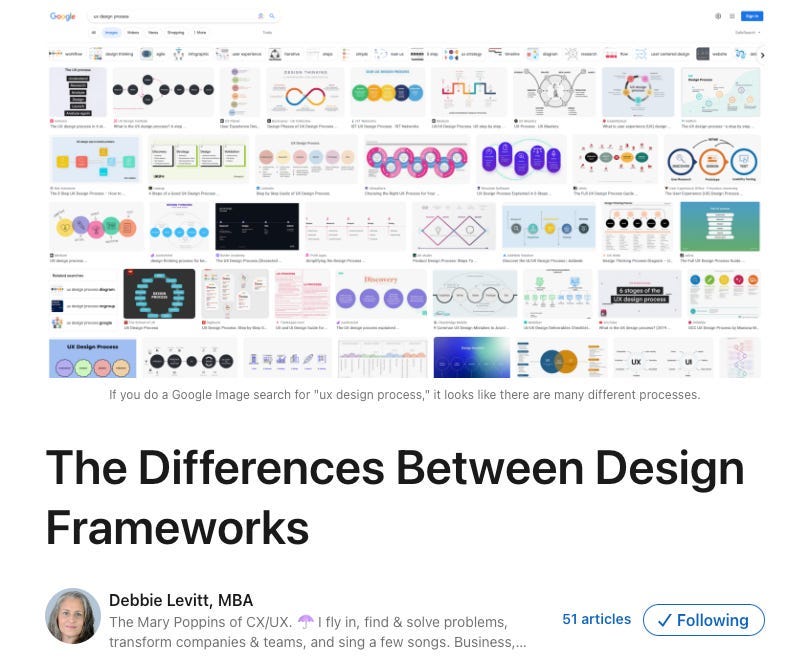
As long as you stick to a few main principles, the name doesn’t matter.
- Understand the problem to solve
- Create a solution
- Test it
The most well-known design process is the Double Diamond, created by the Design Council. This is based on UCD, providing clear phases to take you from problem to solution.
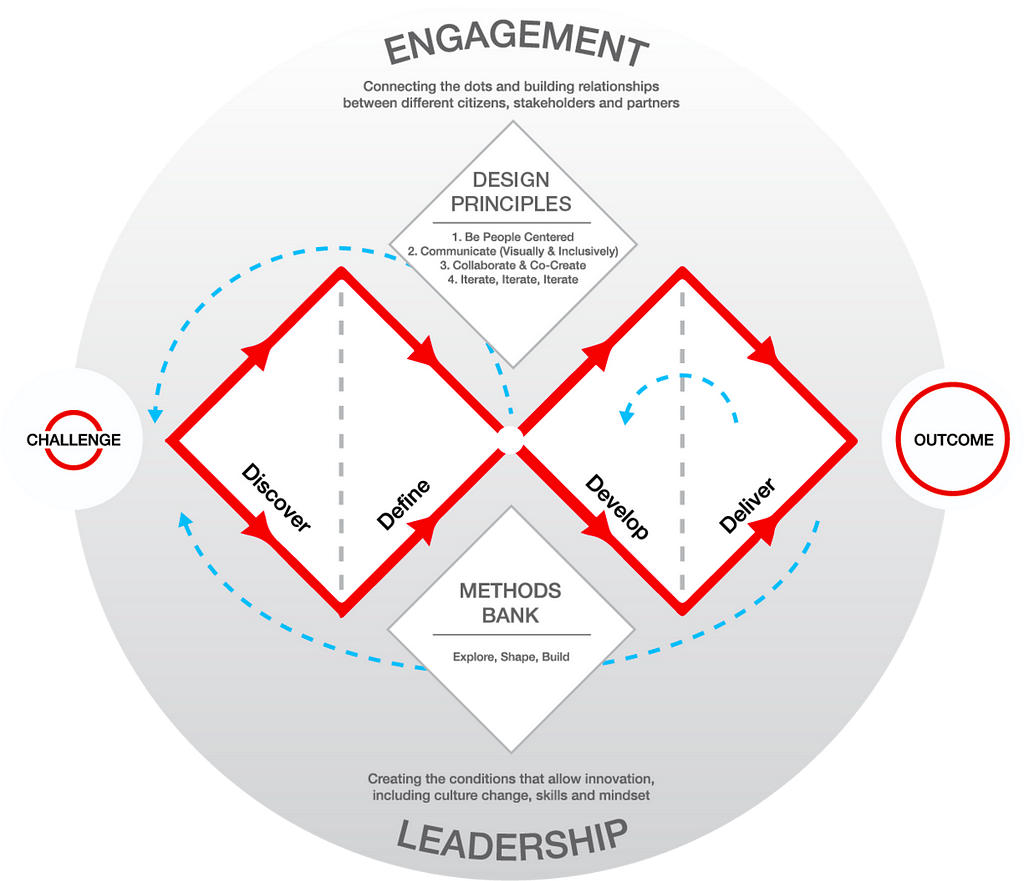
The fundamental of this process is like any UX process:
- Understand the problem. Your business might have an assumption or a real issue connected to a product or a service. You can delve further into the problem through user research.
- Define the problem. Once you have researched the problem, you can start defining it based on the insights gathered. This helps narrow down your problem area.
- Design the solution. It’s now time to design your solution and explore different ways that you can solve the problem.
- Test. When confident with a solution, you can gather further user insights by testing it. Then, you create more designs and test them until you have a solution that fits your user needs and helps the business achieve its goals.
The Design process: real world
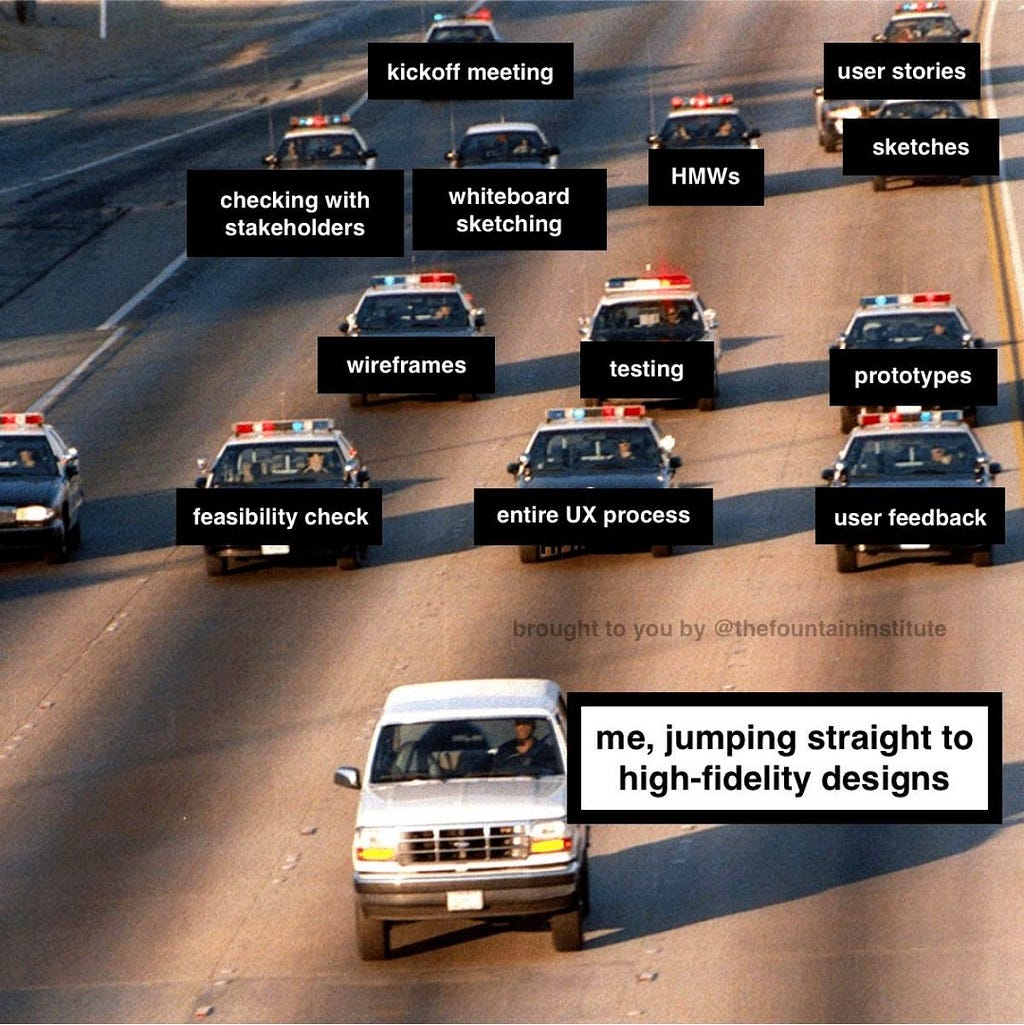
You are probably thinking that you do not always go through those steps. Sometimes, you are given a defined problem to solve and start designing immediately. On other projects, the time allowed for generative research is just a few days at the beginning of the sprint, so you only have the time to do basic desk research. You are not alone!
Many businesses do not have well-defined product development processes and do not understand the value that research and design can add to generate revenue, find product market fit, or whatever their goals are.
This generates low job satisfaction among designers, who are frustrated because they spend most of their time fighting for better processes or just get bored pushing pixels rather than contributing to understanding the problem and finding the right solution.
When we look at design processes, they feel like a utopia. We can’t get all those steps in place in our projects. The reality, though, is that we don’t really have to.
Applying a UCD approach will vary depending on the project and the business. Sometimes, the company already has tons of knowledge in a problem area, and you are working on contained scenarios. Therefore, you might decide that you do not need to run extensive research. Other times, you might work on an entirely new product and decide to run comprehensive research to understand more about the problem area.
As long as you keep close to your users, relying on internal knowledge, going straight to design or conducting extensive generative research are all great ways to design with UCD in mind.
Break the UX design process
Business problems are different and do not always require the same level of research, definition, design and testing.
So, if the design process isn’t always the same, it doesn’t matter, and it’s probably a good thing. Even if a good understanding of a design process is essential, you must use your critical thinking to evaluate the best process to get to the solution.
In his article, Ben Brewer provides many examples of moving the focus from sticking to a design process to having a series of tools that designers can use depending on the problem. He focuses on understanding the knowledge around a specific problem space and its associated risks. Based on these factors, designers can evaluate the best tools to use to get to an optimal solution. The more the risk, the more research is needed.
Scenario 1
Suppose you have problems with many unknowns and a high degree of risk. In that case, you might want to invest more time in generative research to understand the users and the market better, aiming to find ways to summarise the context for the business.
Scenario 2
If the risk is high, but you have a good understanding of the problem space, you might want to spend less time on generative research and go straight into mapping out the problem and creating initial ideas on how to solve it. Be careful, as most companies think they know the users and the market well when, realistically, that’s not always the case.
Scenario 3
With problems that are low risk and within your problem space, you can feel more confident in creating something straightaway and testing it out with users, gathering data and iterating on them.
With a design tool approach, you can be more flexible in identifying the best starting point for building a customer-centric culture in your organisation.
Customer centricity
Now that we are less focused on the process and more on solving problems in the best and most efficient way possible let’s look at the concept of design maturity as a basis to take the business towards a more customer-centric culture.
The NN/g group defines design maturity as the ‘[…]quality and consistency of research and design processes, resources, tools and operations, as well as the organisation’s propensity to support and strengthen UX now and in the future through its leadership, workforce and culture.’
As you can see from this definition, the design process makes an appearance, but it’s not everything you need for a mature design practice. It’s about quality and consistency, as well as supporting and strengthening the value and role of UX.
Why are we talking about design maturity?
I think design maturity is crucial for teams just getting started and finding their feet in organisations that aren’t aware of what customer-centricity means for them. That’s the position I have found myself in quite a few times!
When we have a business that gets designs and its value, it allows teams to connect to their users and not just create screens. Designers who are closer to customers can help the business make a difference. So, if we elevate our design practice and mature, we can be more customer-centric. This article from Reforge articulates much better than I could do.

Why should we fight for customer centricity?
The answer is simple: to increase revenue, help businesses achieve their goals, and of course, fulfil user needs and goals.
Many companies achieve good results, close deals, and make money. This is what a business is set to perform. What if the business can achieve more? What if there’s a differentiator that can allow the company not just to have good results but extraordinary results? What if a business can change people’s lives for good?
Customer centricity is the differentiator.
McKinsey wrote an extensive report in 2018 based on five years of research that analysed millions pieces of financial data and linked those to thousands of design actions. This led to the MDI (McKinsey Designer Index), which analyses the characteristics of businesses that show excellent design practices that contribute to creating business value.
The results showed that those companies with excellent customer centricity have far superior business performance, generating higher revenue and higher returns for their shareholders.
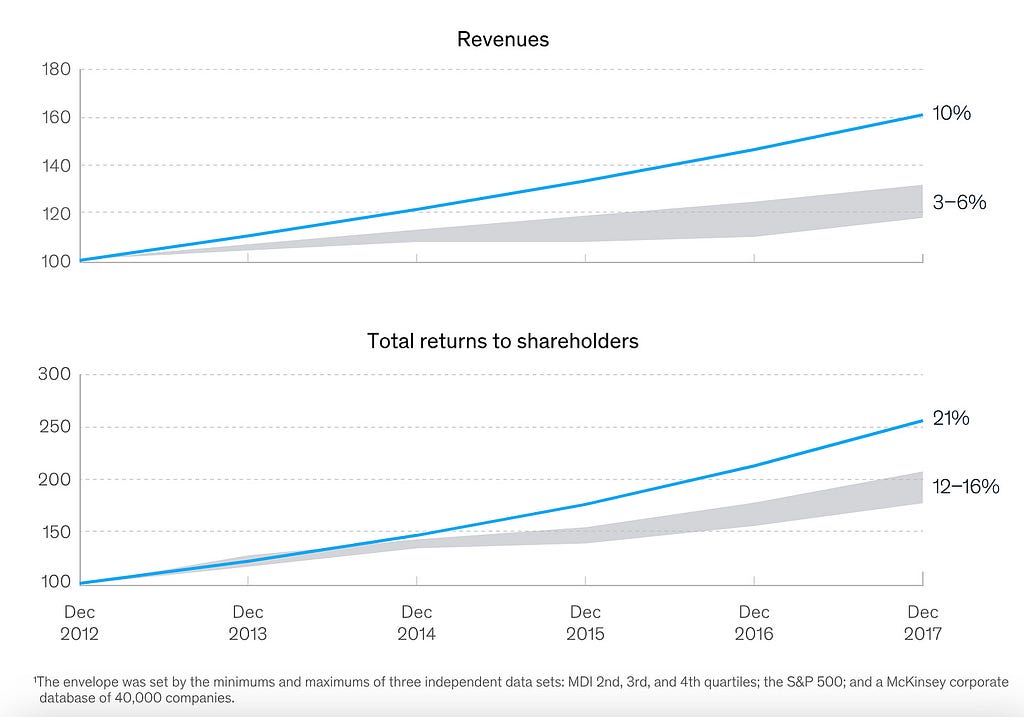
Customer centricity allows businesses to work closer to their customers, understand them further and identify needs, goals and pain points necessary to create products and services that people buy. Customer centricity can allow businesses to increase sales, improve customer satisfaction and reduce costs, generating exponential business value.
Starting from design maturity
When you work in a company that sees designs as a screen factory, the conversation about customer-centricity needs to start from a completely different level. Telling your manager, often in product, marketing, or technology, that designs can help with the revenue target might seem abstract and far from adding the icon to the screen they need now.
How do we engage managers and stakeholders?
I have found the conversation around design maturity very helpful in showing the business the steps to take to customer-centricity.
InVision has created a categorisation to identify companies’ design maturity, which shows how you can strengthen design culture and perception across the business. Through comprehensive research, they have built five levels that span from companies that use design to create screens to companies that see designers setting the vision of the whole business. That’s where we want to get, and that’s what’s best for the business.
You can find a recording of the talk about design maturity level at InVision here.
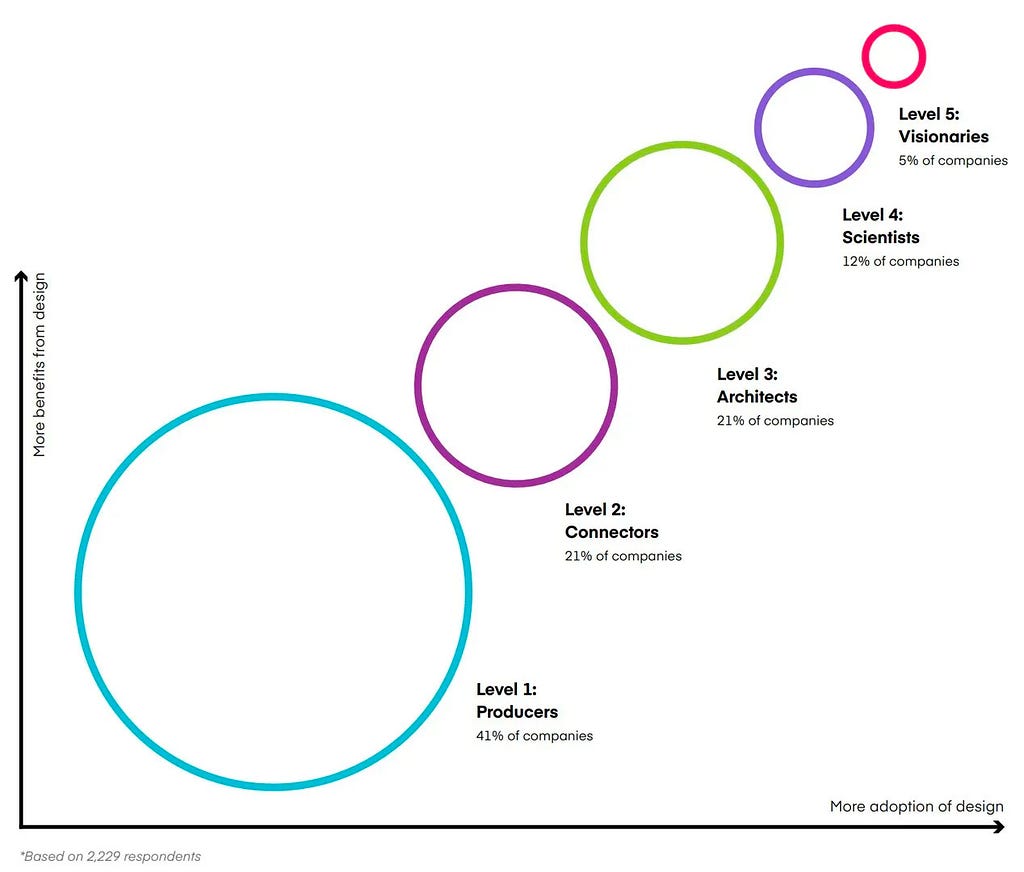
Each level describes how the design practice looks and what impact designers can make in the organisation. By putting you and your company on this matrix, you can see the steps you need to take to grow your maturity level.
L1 Producers — Designers are concerned with Pixel pushing and only designing screens. They create wireframes, visuals and prototypes, which means they can only contribute to the product’s aesthetics.
L2 Connectors — Here, designers start to branch out and connect to other teams through conversations and workshops, nurturing a good level of collaboration that helps contribute to customer satisfaction, not just aesthetics.
L3 Architects — Designers start to get more systematic in their practice by introducing things like design systems, and they work closer to the product to contribute to the vision and strategy. Therefore, they get involved in high-level organisational conversations and can impact revenue.
L4 Scientists — Designers get very scientific about how we make decisions, and there’s a lot of testing and learning involved in the day-to-day practice. Data becomes vital to guide decisions and unlock key business benefits.
L5 Visionaries — Designers drive business strategy and look into the future, setting the pace for company direction.
Stepping stone
In many of my jobs, agency and in-house, I started from a producer level. I have noticed a middle level between the so-called ‘Producer’ and ‘Connector’ when designers go from simply designing screens to caring about usability.
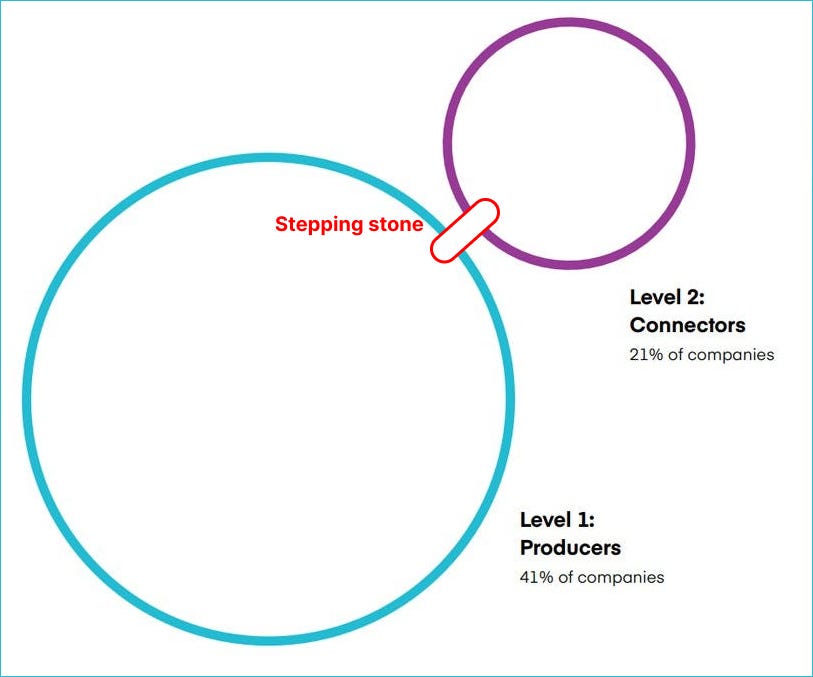
At this stage, designers run or get involved in usability testing, measuring their designs against users’ needs, goals and pain points. This is a crucial step when designers show the importance of users, bringing them fully into the design process and decision-making, and they can start growing maturity to the next level.
Measuring focus and impact
Whatever the level, there are two main things I find particularly useful when it comes to describing a company’s design maturity. It’s the design focus and impact.
The focus is what designers do on a day-to-day.
This goes from being constantly in Figma pushing pixels to other activities focusing more on users’ needs and goals. They start conducting usability testing, then participating in generative research, expanding to running workshops, and participating in C-Level meetings to shape the company strategy.
The impact is what designers influence.
This usually starts with measuring the design effectiveness and usability, growing towards impacting the customer experience, then business profitability, expanding to revenue and the shape and culture of the entire business.
So, think about what you do daily and where your impact is visible. Once you know that, you can start planning to change focus and impact.
Putting the foundation in place for customer-centricity
So, if you find yourself in a company that doesn’t understand customer centricity, looking at a design maturity model can help you plan the work you need to do to take your company closer to your customers and build a more customer-centric business — or at least a better design practice to start with. But changes do not happen overnight, or at least it never happened to me that way. It takes time. But, when you know what is missing in your design practice and understand the business goals, you can create a plan to introduce key design activities to help your business grow and mature your design practice.
Fighting for customer-centricity
What can you do as a designer to drive the business towards customer-centricity? You have two options: quitting or fighting.
There isn’t a right or wrong answer to the question, and it’s really about what you enjoy doing as a designer. You can decide to quit as the company is unsuitable, and you want to move to an organisation that understands design and allows you to do your best work. Alternatively, you can decide to stay and start changing things yourself.
One thing worth considering when pondering your answer is the environment around you. To start changing things, you must ensure the company is ready for that change. It doesn’t mean revolutionising the entire product development process because, let’s be honest, we do not have that power as designers. However, you might see interest from other people in the business, such as product and sales, in changing how the company operates. If you do not see that, there is probably a correct answer: quitting!
A Neapolitan saying puts this the right way ‘A lava’ ‘a capa ‘o ciuccio se perde l’acqua, ‘o tiemp e ‘o ssapone’. It means that you only waste water, time and soap when cleaning a donkey.
There’s no point in arguing in specific settings and with certain people who aren’t interested in different viewpoints, and it would be impossible to make changes happen.
Gain UX maturity one step at a time
My UX career has focused on growing customer-centric culture in various businesses from agencies, social enterprises and in-house tech teams. Those companies have been doing excellent design work but were only marginally geared towards users. My job has focussed on evangelising the importance of users within the product development process and reducing guesswork when it comes to generating impact.
Looking back at my work, I have noticed three clear patterns that have been pivotal to increasing customer centricity:
- Start with people
- Start small and grow from there
- Overshare your work
1. Start with people
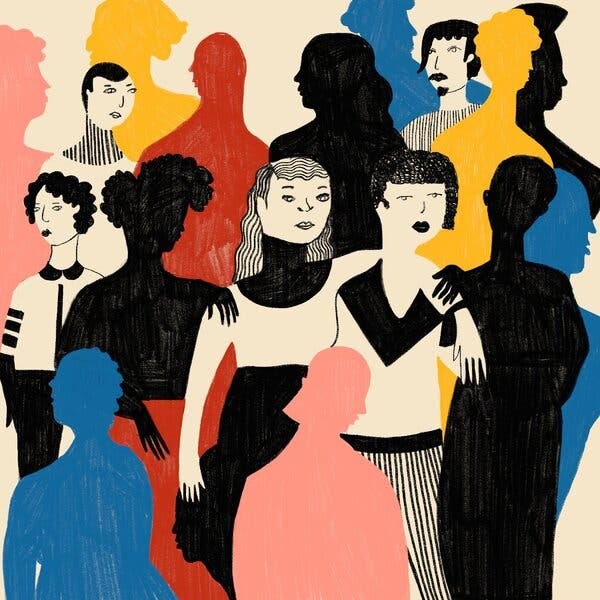
Introducing new processes in any type of business is tricky. People naturally resist change, especially if it means learning new things or changing how they’ve been doing things for a long time. This is especially true in businesses where many people work across the development process, and many perspectives and opinions are often involved.
Introducing a new way of thinking without breaking the process (or people!) is challenging but not impossible if done correctly.
I have witnessed and made this mistake a few times when I went into a new organisation. I immediately see that something doesn’t work and decide to change the world. What usually happens is that people turn against you.
Kim Scott well describes the results of building in silo in her book Radical Candor:
Telling people what to do didn’t work. At a time when we were obviously in need of big change, it has seemed like it was the fastest way forward, but it wasn’t. First, because I didn’t involve my team in the decision-making, I just made the decision myself. Second, because even after making them, I didn’t take the time to explain why or to persuade the team I’d made good decisions. So instead of executing on decisions they didn’t agree with or even understand, my team dissolved, and I wasn’t going to improve our result until I rebuilt it.
Therefore, the best way to make changes is with people, involving key stakeholders in the decision-making process and understanding their pain points to address them when introducing changes.
Here are a few things worth focusing on in building a customer-centric culture with people.
Build relationships
Get to know the key stakeholders and understand their roles and responsibilities. This will help you build trust and rapport, which is essential to understanding who has the most influence and getting their buy-in.
Make relationships as widespread as you can.
Relationships can and should be as widespread as possible. Think about salespeople, customer service, product managers, marketing or engineering. Design is just a cog in an extensive system. Let’s acknowledge that without the other cogs, we wouldn’t be able to achieve much. So get talking to the other folks and empathise with their view of the world.
Treat every conversation as a user interview.
Once you have built connections, treat the conversations as user interviews to understand stakeholders’ challenges in their day-to-day jobs and evaluate how design can help solve problems. For example, if a salesperson is trying to get a client over the line, is there anything that you can do for them? If so, why not help?
Example: the power of artefacts to enhance communication
I want to tell you about my agency experience and how important it was for me to build solid relationships across teams from the start.
When I started as a design lead, I quickly noticed a considerable separation between designers and engineers. There was a lack of communication regarding project goals, and the work was disconnected.
One of the recurrent problems was during the development stage of projects. Engineers argued about why we were designing pages, modules or components in specific ways and pushing back on interactions that took longer to develop. The discussions weren’t particularly articulate. There was little research and zero artefact to show the thinking behind specific design decisions. It was just designers against engineers. It wasn’t fun for anyone.
The relationships I built with project managers, engineers, and designers became helpful in understanding more about the problem, its nature and the frustrations of each person involved. That helped me define the main problem around communication and understand that we needed something to bring everyone on the same page. We didn’t need anything fancy, just something quick and cheap to allow the whole project team to be more aligned from the beginning of each project.
I decided to create more artefacts on one of the projects I was working on. These were cheap and relatively quick to produce. Sometimes, they were based on insights provided by the clients, and other times, they were more assumption-based (don’t judge me; things aren’t perfect straightaway!)
It allowed me to create opportunities to get designers and engineers together to brainstorm ideas for artefacts and designs, and get everyone involved in the work from the early stages. It was great to see everyone thinking about the users to create proto-personas or explore the ultimate user journey for primary users. This changed the work dynamic, making the process more collaborative and the people more aligned. We even changed the office layout to have designers and engineers working on the same project sit together so that they could collaborate more. We all argued for the sit by the window, but the work became much more fluid.
It proved the importance of creating specific artefacts to support internal communication.
It was an imperfect start, but it helped to direct the conversation towards more user-centred practices that could help internal communication flourish. Eventually, the entire agency approach shifted much more towards research with the clients, too.
2. Start small and grow from there
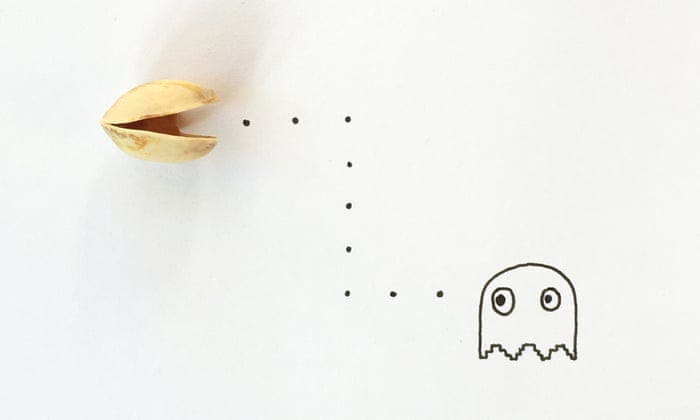
Introducing a fully formed design process that includes generative and evaluative research, as well as design exploration, prototyping, and documentation, is a lot even to write down.
Introducing so many processes at the same time would be not only challenging but also pretty insane. Whatever you learn from books might not work precisely the same way in reality, and this is because companies are different, and people within companies are even more varied than you can think.
I see some designers fighting and shouting to introduce more research and asking businesses for 2–3 months to run generative research. That’s a valid request; if you can get the business to do it, that’s great. However, I haven’t seen this effective unless the business has been educated gradually on the importance and effectiveness of research.
As much as for design, when thinking about driving a business towards customer centricity, you want to have an iterative process, make small changes, and see how they perform and affect your users.
Realistically, you don’t know how changes will land in the business, the best way to fit research into a squad (what about multiple squads?!), or the best way to document insights. Therefore, start small, evaluate what works and doesn’t and go from there.
When you introduce minor changes to the product development process that involve the least amount of people, your success rate will be high. If you don’t ask people to do any additional work or change how they do their job, there’s very little that people can argue against your approach. This could be where you can start.
Example: introducing small research nuggets
What I have seen working well in businesses is the introduction of usability testing. This can be run inexpensively using free video-call software and the current customer base without spending money on expensive panels.
If you work in B2C companies, finding potential users can be pretty straightforward as many people around you might be using your product; if that’s not the case, you can use company channels like newsletters or social media to recruit research participants. If you work in a B2B company like me at the moment, recruiting can be trickier as your user base might be more niche and difficult to source. The way I have solved this problem is by working very closely with salespeople and onboarding managers so that I can count on them for introductions to businesses.
Usability tests are an easy win because they show excellent actionable insights straightway. They are easy to share with people and grab people’s attention — everyone wants to see how customers use your product and what they think about it. Also, it’s tough to ignore participants who cannot complete a task or complain about how a feature has been built. Once you have customer feedback, and people will ask designers to address it.
I have introduced usability testing methodology under the surface of projects multiple times in my jobs and have always seen significant reactions from everyone in the company, from product managers and engineers to the CEO. I have engineers asking to join usability testing or to be able to watch recordings. People start asking for more, and you will be asked to do the same thing when a new project comes your way. Other squads might be asked to do the same, which is when you have built the first step of your customer-centric culture.
The best part of it all is when you start getting results in terms of adoption, NPS score, conversation rate or whatever you use to measure the impact of your design.
One of the projects I worked on was about creating a collection option on checkout for retailers in Australia. The business wanted to drive more usage of the click-and-collect options versus home delivery. We had loads of ideas, and we started to test them out. We quickly realised that whatever we did, users were always selecting the quickest option on the checkout and for click-and-collect, this one was the first one on the list. Seeing users navigating the checkout allowed us to develop a very simple idea, making the click-and-collect faster than home delivery by providing users with a preselected option — no need to scroll a list or browse a map. The result was that click-and-collect doubled on our retailers’ checkout.
You can use this victory to introduce generative research and start understanding more about the problems, ensuring you are solving the right thing. Again, this is not aiming for perfection, but it’s about putting together the building blocks necessary to show the value customer centricity can bring to the business.
3. Overshare your work
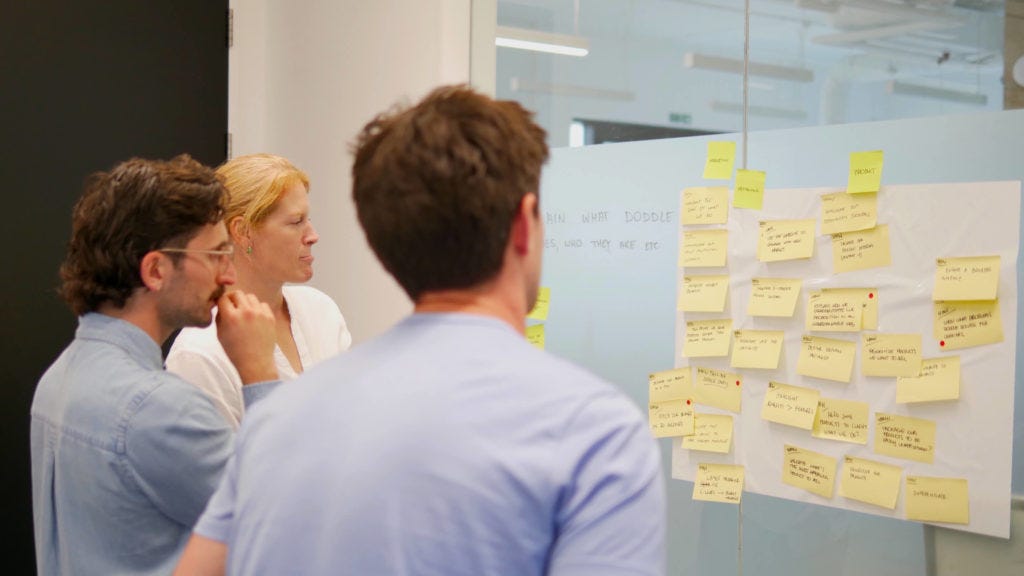
As designers, we are constantly evaluating experiences and products around us. It’s our default approach to focus on aspects like aesthetics, layouts, and user interactions. It’s second nature to us, and removing our designer hat is hard.
When we discuss products, we often assume that everyone is on the same page, thinking they can see things in the same way we can see them. However, this assumption couldn’t be further from the truth. We all tend to exist within our echo chambers, with our specialised jargon. Our cognitive processes vary widely.
Think about your Sales Director and their day-to-day job. They are looking at the customer pipeline and finding the best way to engage them. They have their tactics and methodology to close as many contracts as possible. They don’t discuss typography, colour accessibility, or generative or evaluative research. As much as you have no idea about the best way to manage the sales pipeline, they have no clue about usability testing, and the benefits such methodologies could provide to the business.
Julie Zhuo puts it well in this article
Communicate very explicitly what you think success in your role looks like: don’t assume people know, and don’t assume ill intent. [..] My goal is to make this feel like an easy-to-use experience that our customers love, not just to make each screen look nice. Or My goal is to help us arrive at the product idea will work the best for people. Or My goal is to help us get to a shared vision of what problems our product could solve a year out.
It falls upon us, as designers, to take on the role of educators, helping people across various departments comprehend the profound impact of user-centred design. This approach doesn’t just benefit designers; it can provide results that align with goals from marketing, product, sales, and beyond.
Other people in the organisation aren’t discussing design daily, so they need reminders about our work. Every chance you get is an opportunity to connect them to the users.
The most effective way to educate people is by sharing as much as possible about what we do, the results and the benefits. Don’t stop sharing until you’ve shared so much that you’re tired of repeating yourself. And even then, consider repeating yourself a couple more times.
Example: getting a spot in company meetings
In my current role, my team and I have shared every research we conducted with the entire company. Each type of research offers a unique opportunity to connect with users, and the insights we gather about a product, a question, or a problem can provide valuable information not just for the specific products or features we’re working on but for the entire company’s strategic direction.
When we began conducting usability tests, we created two types of reports using Confluence — this was the best option as everyone in the business already used it. One was a concise one-pager summary containing key insights, with links to video snippets so that people could see how participants used our product. This could be shared easily with most people around the business. The other was a more detailed report for those who wanted to delve deeper into the findings. Both reports were available to everyone.
Additionally, we started presenting these insights during our All-hands meetings. We explained our research methodology, emphasised its importance, and showcased snippets of participants using the product. This captured everyone’s attention and started to change the perception of what design does and can do to help develop products.
Sharing often and widely opened the doors to more research and different types of research.
When a significant question was raised about a product’s performance in the market in which we were operating, the business felt comfortable creating a cross-functional team and asked the design team to find out more about it. We were given more time than usual to run the project, so we ran a small generative research sprint to understand more about the users, and we ran multiple evaluative sessions to refine and iterate on design ideas. It wasn’t months, and it wasn’t enough, but we accepted the challenge, knowing that we could use it to prove the benefits for the future. We came up with innovative ideas that we wouldn’t have the necessary information to even think about before.
This approach gave a different light on how we could think about the product and our users, as we had some real insights! The business could see our work and the benefit of using research to drive design and product decisions.
This also changed people’s perceptions about what the design team was able to do and how they could help contribute to the success of the product. No longer after that, designers were sent on trips to conduct ethnographic research in different parts of the world to investigate how people used our products.
Wrap up
Building relationships, starting small and oversharing work helped establish the basis of a culture that doesn’t see design as the team for making screens look good. Design now solves problems by connecting the business to its users’ needs and goals. This isn’t perfect, and it’s a process that won’t be completed soon. However, it has the foundational pillars of a design culture that can allow for growth.
Get more articles on my Substack or follow me on LinkedIn
Originally published at https://raffdimeo.com on October 24, 2023.
Is the design process a utopia? was originally published in UX Collective on Medium, where people are continuing the conversation by highlighting and responding to this story.

Leave a Reply